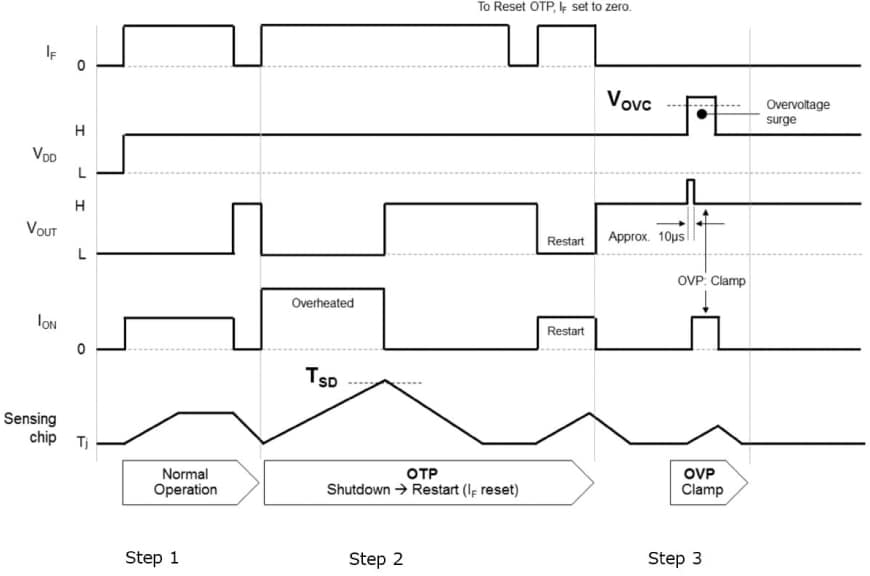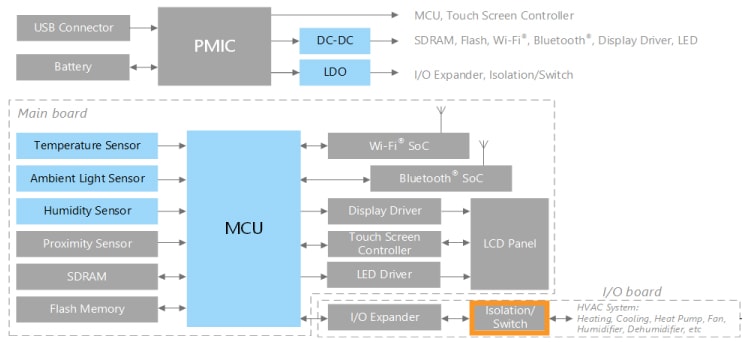- General Top
- SEMICONDUCTOR
- STORAGE
- COMPANY
-
My ToshibaSemicon
- Semiconductor Top
-
ApplicationsAutomotive
Body Electronics
xEV
In-Vehicle Infotainment
Advanced Driver-Assistance Systems (ADAS)
Chassis
IndustrialInfrastructure
BEMS/HEMS
Factory Automation
Commercial Equipment
Consumer/PersonalIoT Equipment
Healthcare
Wearable Device
Mobile
Computer Peripherals
-
ProductsAutomotive Devices
Discrete Semiconductor
Diodes
Transistors
Logic ICs
Analog Devices
Digital Devices
Wireless Devices
※
: Products list (parametric search)
Power SemiconductorsSiC Power Devices
※
: Products list (parametric search)
Isolators/Solid State RelaysPhotocouplers
Digital Isolators
Solid State Relays
Fiber Optic Transmitting Modules
※
: Products list (parametric search)
MOSFETsIGBTs/IEGTsBipolar Transistors※
: Products list (parametric search)
Diodes※
: Products list (parametric search)
MicrocontrollersMotor Driver ICsIntelligent Power ICs※
: Products list (parametric search)
Power Management ICsLinear ICs※
: Products list (parametric search)
General Purpose Logic ICsLinear Image SensorsOther Product ICsOther Product ICs
※
: Products list (parametric search)
-
Design & Development
Design & Development
Innovation Centre
At the Toshiba Innovation Centre we constantly strive to inspire you with our technologies and solutions. Discover how to place us at the heart of your innovations.
-
Knowledge
Knowledge
Highlighted Topics
Further Materials
Other
- Where To Buy
- Part Number & Keyword Search
- Cross Reference Search
- Parametric Search
- Stock Check & Purchase
This webpage doesn't work with Internet Explorer. Please use the latest version of Google Chrome, Microsoft Edge, Mozilla Firefox or Safari.
require 3 characters or more. Search for multiple part numbers fromhere.
The information presented in this cross reference is based on TOSHIBA's selection criteria and should be treated as a suggestion only. Please carefully review the latest versions of all relevant information on the TOSHIBA products, including without limitation data sheets and validate all operating parameters of the TOSHIBA products to ensure that the suggested TOSHIBA products are truly compatible with your design and application.Please note that this cross reference is based on TOSHIBA's estimate of compatibility with other manufacturers' products, based on other manufacturers' published data, at the time the data was collected.TOSHIBA is not responsible for any incorrect or incomplete information. Information is subject to change at any time without notice.
require 3 characters or more.
Contributing to improved reliability of equipment in intense noise environments

Toshiba just released and begun mass production of TLP241BP, the first DIP4 package photorelay[Note 1] with OFF-state output terminal voltage 80 V, over temperature protection and over voltage protection functions.
Photorelays (MOSFET out photocouplers) are a type of switch, but they offer the following benefits compared to conventional mechanical relays due to the use of semiconductor switches. Therefore, it is suitable for building automation and home automation related applications that require a long service life and quietness.
- No contact life on the output side because there is no physical contact
- Semiconductor switch, so no sound is produced when switching
- Low drive power
- Small size
In office buildings, a system called “Building Automation” is introduced, which provides fine control of air conditioning and lighting in order to achieve carbon neutral. In buildings that consume a large amount of energy, control is required to achieve efficient energy use when constructing new buildings. In addition, existing buildings are also required to achieve the same level of efficiency when replacing equipment. Thermostats are increasingly required to serve as one terminal for building energy management systems (BEMS) that use big data. Thermostats are also required to function as part of a large-scale system, which requires longer operating times and more stable operation. It is also used as a terminal for a home energy management system (HEMS) that enables consumers to manage energy by connecting to photovoltaic power generation equipment and other devices, while visualizing in real time the use and operating conditions of electrical equipment used in their homes. Thermostats and other devices incorporate various types of information, such as temperature, humidity, and brightness, into the system for air conditioning and lighting control that combines comfort with energy conservation. Switches are often used as interfaces for this equipment.
The new TLP241BP is equipped with an over temperature protection function that forcibly turns OFF the output-side MOSFET when the temperature-rise exceeds the rating due to excessive applied current to the photo-relay, etc. In addition, an active clamping MOSFET is provided to protect the device when an overvoltage exceeding the blocking voltage rating is applied at OFF state of the output-side MOSFET. These functions make it possible to protect equipment used in severe noise environments such as air conditioning systems, thus contributing to improved reliability of the equipment.
[Note 1] With a photorelay of ON-current rating 1A or higher, October 2023, our investigation.
Features
- Over Temperature Protection (OTP)/Over Voltage Protection (OVP) function
- OFF-state output terminal voltage/ON-state current rating ideal for thermostats
- Achieves high isolation voltage
1. Over Temperature Protection (OTP)/Over Voltage Protection (OVP) function

The over temperature protection function prevents the device deterioration and destruction due to a remarkable rise in ambient temperature or unexpected heat generation of the device itself in a high-current load. The over voltage protection function suppresses over voltage and protects a device when the input side or output side becomes over voltage due to external surge voltage (lightning, static electricity, etc.) or device abnormality.
TLP241BP has an over temperature protection function and an over voltage protection function. The sequence of the protection functions is shown in the timing chart. LED forward current on the input side is IF, and the current on the output side is ION.

Since TLP241BP is 1a contact (normally-open type), in normal operation (step 1), the output-side is turned on and the current flows when IF is input, as in normal photorelay. If a current greater than the rated ION flows through the device, TLP241BP is over temperature status and the over temperature protection (OTP) is activated (step 2). This causes the egress to shutdown and continue to OFF until IF is reset. The over temperature protection function shuts down the output when the device overheats for some reason. In OVP mode, an active clamp MOSFET is used on the output side. When the output side OFF and overvoltage are applied, the output side is clamped by overvoltage protection, causing ION to flow temporarily.
2. Inhibit OFF-state output terminal voltage/ON-state current rating ideal for thermostats
Existing BEMS and HEMS have various forms of management systems that connect various terminals and devices. The thermostat, which is one terminal of this system, is always connected. Devices to which thermostats are connected mainly to air conditioners, and they are constantly exposed to noise and abnormalities. Isolation from the system is essential to avoid this risk. Photorelays are preferred for such insulation.
Though many of the thermostats used in these applications have AC24 V power supply voltages, TLP241BP uses 80 V MOSFET to accommodate AC36 V and AC48 V power supply voltages. In addition, the on-current rating has been made 1.4 A to accommodate HVAC[Note 2] systems that handle large currents.
[Note 2] Heating, Ventilation and Air Conditioning


3. Achieves high isolation voltage: 5000Vrms
There are various ways to ensure the safety of electrical equipment. When electrical equipment breaks down, consumers must prevent electric shock and fire accidents. In particular, the dielectric strength must not be sufficient to ensure safety in the event of an electrical problem in addition to the voltage normally handled. TLP241BP realizes the smallest dielectric strength 5000Vrms and can be used for equipment that requires higher insulating performance, thus contributing to ensuring the safety of equipment and consumers.
Applications
- BEMS/HEMS equipment
- Thermostat
- Various sensor controls
- I/O interface
- Battery management system
- Replacement of various mechanical relays
Main Specifications
(Unless otherwise specified, Ta=25°C)
| Part Number | TLP241BP | |||
|---|---|---|---|---|
| Package | DIP4 | |||
| Contact type | 1a | |||
| Protective Function |
Thermal shutdown temperature TSD (°C) | Typ. | 145 | |
| Over voltage clamp VOVC (V) | 80 to 100 | |||
| Absolute Maximum Ratings |
OFF-state output terminal voltage VOFF (V) | 80 | ||
| On-state current ION (A) | 1.4 | |||
| On-state current (pulsed) IONP (A) | 4.2 | |||
| Operating temperature Topr (°C) | -40 to 110 | |||
| Coupled Electrical Characteristics |
Trigger LED current IFT (mA) | Max | 3 | |
| On-state Resistance RON (ohms) | ION=1.4A | Typ. | 0.16 | |
| On-state resistance RON (ohms) | ION=1.4A | Max | 0.28 | |
| Switching Characteristics |
Turn-on time tON (ms) | IF=10mA, VDD=20 V, RL=200 Ω |
Max | 1.4 |
| Turn-off time tOFF (ms) | IF=10mA, VDD=20 V, RL=200 Ω |
Max | 0.5 | |
| Isolation Characteristics |
Isolation Voltage BVS (Vrms) | Min | 5000 | |
Related information
Product information
Technical Articles
Application
Queries about purchasing, sampling and IC reliability
Stock Check & Purchase
require 3 characters or more.
* Wi-Fi is a registered trademark of Wi-Fi Alliance.
* The Bluetooth® word mark is a registered trademark owned by Bluetooth SIG, Inc.
* Other company names, product names, and service names may be trademarks of their respective companies.

